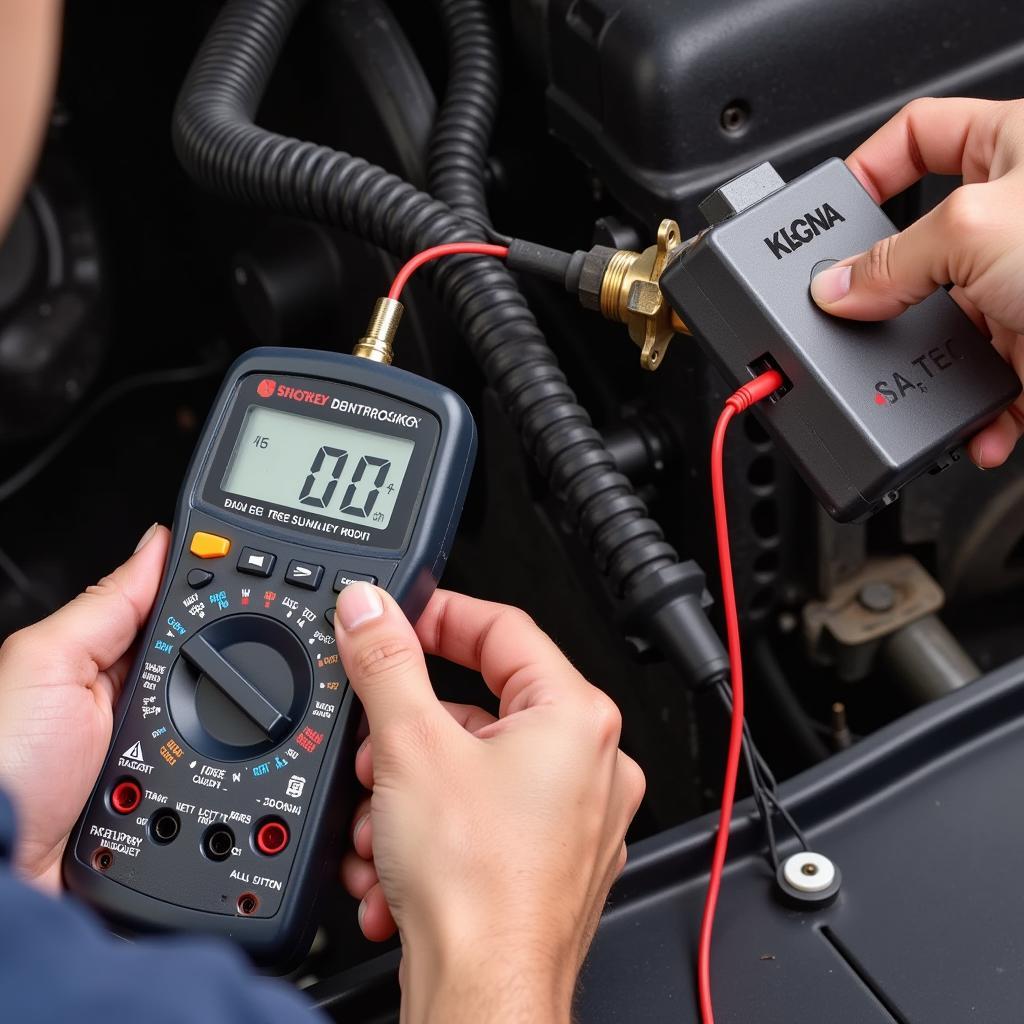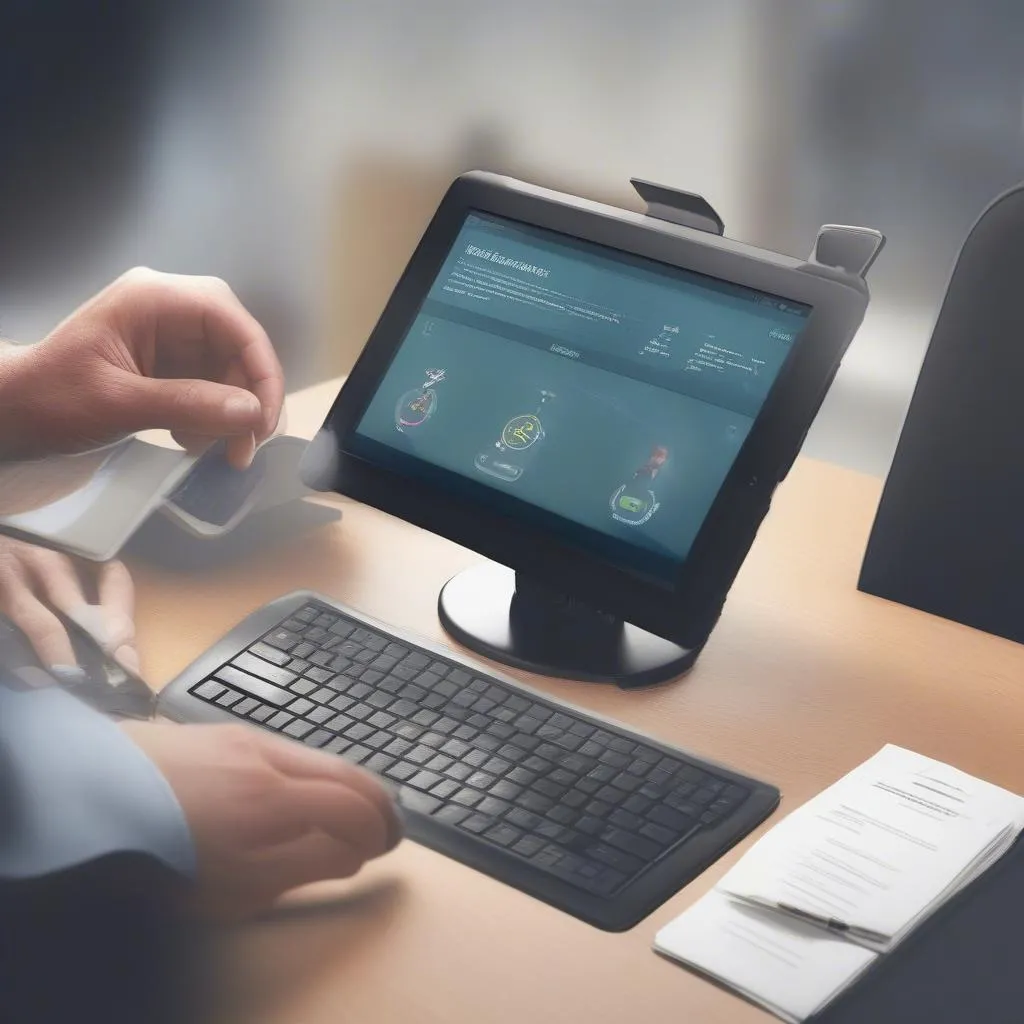The brake pressure warning switch in your Dodge is a critical safety component that alerts you to potential problems within your braking system. When this switch malfunctions, it can trigger a lit brake warning light on your dashboard even when there’s no actual braking issue. This article will delve into the common causes behind a faulty brake pressure warning switch, the symptoms to watch out for, and the steps to diagnose and resolve the problem.
Understanding the Brake Pressure Warning Switch
The brake pressure warning switch, often located near the master cylinder, is designed to detect imbalances in your Dodge’s hydraulic brake system. When you press the brake pedal, the switch monitors the pressure within the system. If it detects a significant pressure difference between the front and rear brake circuits, it signals a potential problem by illuminating the brake warning light on your dashboard. This difference in pressure could indicate a leak in the hydraulic lines, a faulty master cylinder, or a problem with the switch itself.
Common Causes of a Faulty Dodge Brake Pressure Warning Switch
While the brake pressure warning switch itself can malfunction, it’s not always the root cause of a lit brake warning light. Here are some common culprits behind a faulty Dodge brake pressure warning switch:
- Low Brake Fluid: Insufficient brake fluid level is a leading cause of brake pressure warning light illumination. If the fluid level drops too low, the switch may not be adequately submerged, leading to inaccurate readings.
- Worn-Out Brake Pads: As your brake pads wear down, they require more brake fluid to function correctly. This increased fluid demand can sometimes trigger the warning light, especially if the fluid level is already low.
- Faulty Master Cylinder: The master cylinder is responsible for distributing brake fluid to the wheels. If the master cylinder fails internally, it can disrupt the pressure balance in the system, triggering the warning light.
- Brake Fluid Leaks: Leaks in the brake lines or connections can cause a significant drop in brake fluid pressure, leading to an illuminated warning light.
- Malfunctioning Brake Pressure Warning Switch: Like any electrical component, the brake pressure warning switch itself can wear out, corrode, or become damaged over time, resulting in inaccurate readings or a permanently lit warning light.
Symptoms of a Bad Brake Pressure Warning Switch
A malfunctioning brake pressure warning switch can manifest in several ways. Recognizing these symptoms early on is crucial to prevent potential braking issues:
- Illuminated Brake Warning Light: The most obvious sign is a constantly illuminated brake warning light on your dashboard, even when the brakes seem to be working normally.
- Intermittent Brake Warning Light: The warning light may flicker or illuminate intermittently, especially when driving over bumps or turning the steering wheel. This could indicate a loose connection or a failing switch.
- Spongy or Soft Brake Pedal: If the brake pedal feels unusually soft or spongy, it could be a sign of low brake fluid or a problem with the brake pressure warning switch.
- Brakes Engaging at Different Heights: If you notice that your brakes engage at different pedal heights than usual, it could be a sign of uneven brake pressure distribution, potentially linked to a faulty switch.
Diagnosing a Dodge Brake Pressure Warning Switch Problem
Determining the exact cause of a brake pressure warning light requires a systematic approach. Here’s a step-by-step guide to help you diagnose the problem:
-
Check the Brake Fluid Level: The first and most straightforward step is to check the brake fluid level in the master cylinder reservoir. If the fluid level is low, add the recommended brake fluid type to the reservoir, but address any underlying leaks to prevent recurrence.
-
Inspect for Brake Fluid Leaks: Thoroughly examine the brake lines, connections, master cylinder, and wheel cylinders for any signs of brake fluid leaks. Look for wet spots, drips, or stained areas around these components.
-
Test the Brake Pressure Warning Switch: If the brake fluid level is adequate and there are no visible leaks, the next step is to test the brake pressure warning switch itself. You can use a multimeter to check for continuity in the switch’s electrical circuit.
-
Disconnect the electrical connector from the brake pressure warning switch.
-
Set your multimeter to the ohms setting.
-
Connect the multimeter probes to the switch’s electrical terminals.
-
With the brake pedal released, the multimeter should show no continuity (infinite resistance).
-
Press the brake pedal down. The multimeter should now show continuity (close to zero resistance).
-
If the multimeter readings don’t match these expectations, the brake pressure warning switch is likely faulty and needs replacement.
-
 Testing the Dodge Brake Pressure Warning Switch
Testing the Dodge Brake Pressure Warning Switch
Replacing the Dodge Brake Pressure Warning Switch
If your diagnosis points to a faulty brake pressure warning switch, replacing it is a relatively straightforward procedure. However, working with brake systems requires caution due to the hydraulic fluid involved.
Tools You’ll Need:
- New brake pressure warning switch (compatible with your Dodge model)
- Wrenches (sizes may vary depending on your vehicle)
- Container for collecting brake fluid
- Rags or shop towels
Replacement Procedure:
-
Disconnect the Negative Battery Cable: Before starting any work, always disconnect the negative battery cable to avoid electrical mishaps.
-
Locate and Access the Switch: The brake pressure warning switch is typically located on the master cylinder or along the brake lines. Consult your vehicle’s repair manual for the precise location.
-
Relieve Brake Pressure: Before disconnecting any brake lines, you need to relieve the pressure in the system. You can do this by having an assistant press and hold the brake pedal while you loosen the bleeder valve on one of the brake calipers.
-
Disconnect the Switch: Once the pressure is relieved, use a wrench to carefully loosen and disconnect the brake lines from the old warning switch. Have a container ready to catch any remaining brake fluid.
-
Install the New Switch: Install the new brake pressure warning switch in reverse order, ensuring all connections are secure and free of leaks.
-
Bleed the Brakes: After installing the new switch, you’ll need to bleed the brake system to remove any air that may have entered during the process. Consult your vehicle’s repair manual for the correct bleeding sequence.
-
Reconnect the Battery and Test: Once the bleeding is complete, reconnect the negative battery cable and start your Dodge. Check for any leaks and ensure the brake warning light is no longer illuminated.
Expert Insight from John Miller, ASE Certified Master Technician: “Never ignore a brake warning light. It’s always best to err on the side of caution and have your brake system inspected by a qualified mechanic. Even if it turns out to be a minor issue like a faulty switch, addressing it promptly can prevent more serious and costly problems down the road.”
FAQs: Dodge Brake Pressure Warning Switch
Q: Can I drive with a bad brake pressure warning switch?
A: While your Dodge may seem to brake normally, driving with a faulty brake pressure warning switch is highly discouraged. The switch serves as a vital safety feature, and ignoring it could lead to a complete brake failure in critical situations.
Q: How much does it cost to replace a brake pressure warning switch?
A: The cost of replacement can vary depending on your Dodge model and labor rates in your area. However, the switch itself is relatively inexpensive, usually ranging from $15 to $50. Labor costs can range from $50 to $100, depending on the complexity of the replacement.
Q: Can I replace the brake pressure warning switch myself?
A: If you have basic mechanical skills and are comfortable working on your vehicle’s brake system, you can replace the brake pressure warning switch yourself. However, if you’re unsure about any part of the process, it’s always best to seek assistance from a qualified mechanic.
Q: What other lights might illuminate with a brake warning light?
A: If the brake warning light is accompanied by the ABS (Anti-lock Braking System) light, it could indicate a problem within the ABS system itself. A combination of the brake warning light and the battery light could suggest a failing alternator, affecting the electrical system’s ability to power the brakes.
Q: How often should I check my brake fluid?
A: It’s a good practice to check your brake fluid level at least once a month. Inspecting the fluid level regularly allows you to catch potential leaks or low fluid levels early on, preventing more significant braking issues.
Conclusion
Addressing a faulty brake pressure warning switch in your Dodge is crucial for maintaining the safety and reliability of your braking system. By understanding the causes, recognizing the symptoms, and following the diagnostic and replacement steps outlined in this article, you can ensure your Dodge’s brakes are in optimal working order, giving you peace of mind on the road. Remember, when it comes to brakes, it’s always best to prioritize safety and address any warning signs promptly.

